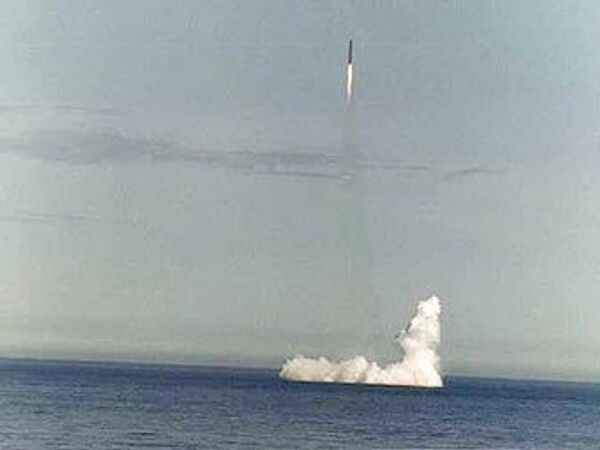MOSCOW, August 14 (RIA Novosti) - Russia's troubled Bulava ballistic missile will be developed and put into service with the Navy, the general designer of the Rubin design bureau for marine engineering has said.
The missile, which is being developed by the Moscow-based Institute of Thermal Technology (MITT), has suffered six failures in 11 tests. The general director of the institute has resigned over the failures, seen as a setback in the development of Russia's nuclear deterrent.
Sergei Kovalyov, who helped design three generations of Russia's strategic submarines, said the testing of Bulava, which is the most advanced submarine-launched ballistic missile ever developed in Russia, is a very complex process and takes time and effort to succeed.
"Beyond any doubt, Bulava is a much more sophisticated missile [than the previous missiles]. Although we lag behind in the electronics, it uses far more sophisticated materials and components. Solid-fuel missiles are used around the world. The Topol [land-based missile] flies. I am convinced that Bulava will fly as well," Kovalyov said in an interview published by the Rossiiskaya Gazeta government daily on Thursday.
The Bulava (SS-NX-30) submarine-launched ballistic missile (SLBM) carries up to 10 MIRV warheads and has an estimated range of over 8,000 kilometers (5,000 miles). The three-stage solid-propellant ballistic missile is designed for deployment on new Borey class nuclear-powered strategic submarines.
The Russian military expects the Bulava, along with Topol-M land-based ballistic missiles, to become the core of Russia's nuclear triad.
The expert dismissed criticism over serious problems in the Bulava missile testing process, saying the designers were forced to bypass required testing stages due to a lack of funds and the lack of necessary facilities.
"In Soviet times, during the first stage of trials, dummy missiles were fired from a floating launch pad in Balaklava [a town on the Crimean Peninsula, which now belongs to Ukraine] to test the underwater segment of the trajectory," Kovalyov said.
"After that, similar tests were conducted on board a re-equipped submarine. They were followed by a number of launches from a land-based launch pad in Nenoks in the Arkhangelsk region to test the flight range," he said.
In the case of the Bulava missile, "there were no conditions to carry out tests at a floating launch pad in Balaklava, and there was no opportunity to conduct ground-based tests of the missile either, because the funds needed to build launch pads and a new silo were not provided."
The expert also complained about the poor quality of missile components provided by a large number of sub-contractors, and the absence of military representatives at manufacturing plants to ensure quality control.
"Some of the failed launches were caused by faulty components, which the military reps would never allow to pass," Kovalyov said.
He also dismissed as "pure nonsense" media speculation that the U.S. was interfering with Bulava tests by using powerful radars or laser beams.
"No country in the world possesses such a capability," the designer said.
The Russian Defense Ministry said in July the Bulava tests could resume as early as in August.




